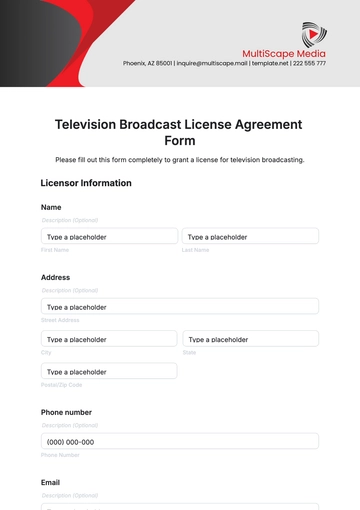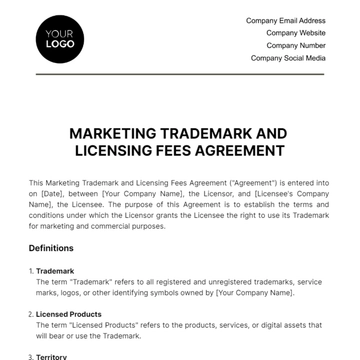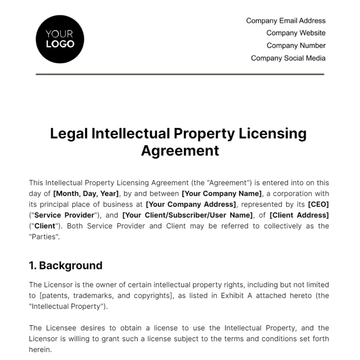Free Blank Movie Theater Film Licensing Agreement

1. Parties
(Identify both the licensor, which is [Your Company Name], and the licensee. Include the legal names, types of business entities, and principal places of business for both parties to establish the agreement's legitimacy.)
2. Grant of License
2.1 Scope of License
(Specify the exact rights being granted to the licensee. Define whether the license is exclusive or non-exclusive and list the specific rights to use, display, or distribute the film within designated locations or formats.)
2.2 Term of License
(State the effective date and duration of the license. Detail any conditions that could lead to earlier termination or extension of the term.)
2.3 Territory
(Define the geographic area where the licensee is allowed to exhibit the film. Be specific to avoid any ambiguities that could lead to legal disputes.)
3. Licensing Fees
3.1 Fee Structure
(Outline the payment structure for the license. This could include a flat fee, a percentage of revenues, or other compensation arrangements. Specify how fees are calculated and any conditions or thresholds that might affect payments.)
3.2 Payment Terms
(Detail the timing of payments, such as monthly or quarterly, and the methods acceptable for payment, like bank transfer or check. Include due dates and any grace periods for late payments.)
3.3 Late Fees
(Describe the penalties for late payments. This could include interest rates or flat fees, and note how they accumulate.)
4. Delivery of the Film
4.1 Delivery Format
(Specify the format in which the film will be delivered to the licensee, such as digital, film reel, DVD, etc., ensuring it's suitable for the licensee’s exhibition technology.)
4.2 Delivery Schedule
(Define a timeline for when the film must be delivered prior to the first exhibition to ensure the licensee has adequate time to prepare.)
4.3 Return of Materials
(Detail the expectations and process for returning the film materials to the licensor at the end of the agreement term, including conditions for the deletion or destruction of digital copies.)
5. Marketing and Promotion
5.1 Marketing Obligations
(State the licensee’s obligations to market the film, including minimum advertising requirements and any promotional appearances or events.)
5.2 Use of Trademarks
(Provide terms for using the licensor’s trademarks and promotional materials. Include any necessary limitations or approval rights to maintain brand integrity.)
6. Reporting
6.1 Box Office Reports
(Require the licensee to provide regular reports on ticket sales and revenues, specifying the frequency and format of such reports to ensure compliance and accurate accounting.)
6.2 Audit Rights
(Give the licensor the right to audit the licensee’s books and records related to the film to verify compliance with financial provisions. Specify the notice period and frequency of audits.)
7. Intellectual Property
7.1 Ownership
(Affirm the licensor’s ownership of the film and related intellectual property, ensuring that the licensing agreement does not transfer any ownership rights.)
7.2 Infringement
(Outline the responsibilities of both parties to notify each other of any intellectual property infringements and detail the process for handling such claims.)
8. Representations and Warranties
8.1 By the Licensor
(List specific assurances provided by the licensor regarding their authority to license the film and the film’s non-infringement of third-party rights.)
8.2 By the Licensee
(Detail the licensee’s warranties regarding their legal authority to enter into the agreement and comply with its terms.)
9. Indemnification
9.1 By the Licensor
(Describe the circumstances under which the licensor must indemnify the licensee.)
9.2 By the Licensee
(Specify how the licensee will need to indemnify the licensor, protecting against losses from licensee’s breach of the agreement or other specified conditions.)
10. Limitation of Liability
10.1 No Consequential Damages
(State that neither party will be liable for indirect damages arising from the agreement to limit potential loss exposure.)
10.2 Cap on Liability
(Specify any maximum limit on the amount one party may be required to pay the other under the agreement, providing a clear limit to financial exposure.)
11. Term and Termination
11.1 Term
(Define the full duration of the agreement, from the effective start date to the end date, including any conditions that could extend or shorten this period.)
11.2 Termination for Convenience
(Allow either party to terminate the agreement for any reason, provided they give adequate notice as defined in the agreement.)
11.3 Termination for Cause
(Specify how and under what circumstances either party may terminate the agreement due to the other party's failure to meet contractual obligations.)
11.4 Effect of Termination
(Detail the obligations of both parties following termination, such as settlement of accounts and return of materials.)
12. Confidentiality
12.1 Confidential Information
(Define what constitutes confidential information and the obligations to protect it, helping prevent the disclosure of business-sensitive details.)
12.2 Non-Disclosure
(Specify the actions required to maintain confidentiality and the permitted uses of confidential information during and after the agreement term.)
12.3 Return of Materials
(Outline the process for returning or destroying confidential materials once the agreement is terminated or upon request.)
13. Governing Law and Dispute Resolution
13.1 Governing Law
(Specify the jurisdiction under whose law the agreement will be governed. This is crucial for determining how disputes will be interpreted and resolved.)
13.2 Dispute Resolution
(Detail the agreed method for resolving disputes, whether through arbitration, mediation, or court proceedings, including the location and procedural rules that will govern such processes.)
14. Miscellaneous
14.1 Entire Agreement
(Clause stating that this document and any exhibits or attachments constitute the entire agreement between the parties regarding its subject matter.)
14.2 Amendments
(Specify that any amendments or changes to the agreement must be in writing and signed by both parties.)
14.3 Severability
(Include a severability clause to ensure that if one part of the agreement is found to be invalid, the rest of the agreement still remains in effect.)
14.4 Waiver
(Define the conditions under which a waiver of any part of the agreement does not constitute a waiver of any other part.)
14.5 Notices
(Detail how notices under the agreement should be given, including forms of acceptable delivery and how they are confirmed.)
14.6 Force Majeure
(Define extraordinary events beyond the control of the parties that may excuse non-performance of the agreement.)
14.7 Assignment
(State restrictions or permissions regarding the transfer of obligations or rights under the agreement to another party.)
14.8 Counterparts
(State that the agreement can be executed in counterparts, which when taken together, will form one legal document.)
(Ensure each section is tailored to reflect the specifics of the agreement and checked by legal counsel to guarantee enforceability and compliance with local laws.)
- 100% Customizable, free editor
- Access 1 Million+ Templates, photo’s & graphics
- Download or share as a template
- Click and replace photos, graphics, text, backgrounds
- Resize, crop, AI write & more
- Access advanced editor
Formalize your film agreements with Template.net's Blank Movie Theater Film Licensing Agreement Template. This template is fully customizable and editable with our AI editor tool, providing a solid foundation for securing the rights to screen various films. It's perfect for movie theaters needing a legally structured and adaptable document for film licensing negotiations.
You may also like
- Lease Agreement
- Non Compete Agreement
- Rental Agreement
- Prenuptial Agreement
- Non Disclosure Agreement
- Operating Agreement
- Hold Harmless Agreement
- LLC Operating Agreement
- Arbitration Agreement
- Purchase Agreement
- Residential Lease Agreement
- Executive Agreement
- Confidentiality Agreement
- Contractor Agreement
- Partnership Agreement
- Postnuptial Agreement
- Collective Bargaining Agreement
- Loan Agreement
- Roommate Agreement
- Commercial Lease Agreement
- Separation Agreement
- Cohabitation Agreement
- Room Rental Agreement
- Child Custody Agreement
- Employee Agreement
- License Agreements
- Settlement Agreement
- Joint Venture Agreement
- Indemnity Agreement
- Subordination Agreement
- Sales Agreement
- Agreements Between Two Parties
- Business Agreement
- Real Estate Agreement
- HR Agreement
- Service Agreement
- Property Agreement
- Agreement Letter
- Restaurant Agreement
- Construction Agreement
- Finance Agreement
- Marketing Agreement
- Payment Agreement
- Investment Agreement
- Management Agreement
- Nonprofit Agreement
- Software Agreement
- Startup Agreement
- Agency Agreement
- Copyright Agreement
- Collaboration Agreement
- Reseller Agreement
- Car Rental Agreement
- Cleaning Services Agreement
- Consultant Agreement
- Deed Agreement
- Car Agreement
- Equipment Agreement
- Shares Agreement
- Data Sharing Agreement
- Advertising Agreement
- School Agreement
- Franchise Agreement
- Event Agreement
- Travel Agency Agreement
- Vehicle Agreement
- Board Resolution Agreement
- Land Agreement
- Binding Agreement
- Tenancy Agreement
- Exclusive Agreement
- Development Agreement
- Assignment Agreement
- Design Agreement
- Equity Agreement
- Mortgage Agreement
- Purchase and Sale Agreement
- Shareholder Agreement
- Vendor Agreement
- Royalty Agreement
- Vehicle Lease Agreement
- Hotel Agreement
- Tenant Agreement
- Artist Agreement
- Commission Agreement
- Consignment Agreement
- Debt Agreement
- Recruitment Agreement
- Training Agreement
- Transfer Agreement
- Apprenticeship Agreement
- IT and Software Agreement
- Referral Agreement
- Resolution Agreement
- Waiver Agreement
- Consent Agreement
- Partner Agreement
- Social Media Agreement
- Customer Agreement
- Credit Agreement
- Supply Agreement
- Agent Agreement
- Brand Agreement
- Law Firm Agreement
- Maintenance Agreement
- Mutual Agreement
- Retail Agreement
- Deposit Agreement
- Land Purchase Agreement
- Nursing Home Agreement
- Supplier Agreement
- Buy Sell Agreement
- Child Support Agreement
- Landlord Agreement
- Payment Plan Agreement
- Release Agreement
- Research Agreement
- Sponsorship Agreement
- Buyout Agreement
- Equipment Rental Agreement
- Farm Agreement
- Manufacturing Agreement
- Strategic Agreement
- Termination of Lease Agreement
- Compliance Agreement
- Family Agreement
- Interior Design Agreement
- Ownership Agreement
- Residential Lease Agreement
- Retainer Agreement
- Trade Agreement
- University Agreement
- Broker Agreement
- Dissolution Agreement
- Funding Agreement
- Hosting Agreement
- Investor Agreement
- Memorandum of Agreement
- Advisory Agreement
- Affiliate Agreement
- Freelancer Agreement
- Grant Agreement
- Master Service Agreement
- Parking Agreement
- Subscription Agreement
- Trust Agreement
- Cancellation Agreement
- Horse Agreement
- Influencer Agreement
- Membership Agreement
- Vacation Rental Agreement
- Wholesale Agreement
- Author Agreement
- Distributor Agreement
- Exchange Agreement
- Food Agreement
- Guarantee Agreement
- Installment Agreement
- Internship Agreement
- Music Agreement
- Severance Agreement
- Software Development Agreement
- Storage Agreement
- Facility Agreement
- Intercompany Agreement
- Lending Agreement
- Lodger Agreement
- Outsourcing Services Agreement
- Usage Agreement
- Assurance Agreement
- Photography Agreement
- Profit Sharing Agreement
- Relationship Agreement
- Rent To Own Agreement
- Repayment Agreement
- Volunteer Agreement
- Co Parenting Agreement
- HVAC Agreement
- Lawn Care Agreement
- SAAS Agreement
- Work from Home Agreement
- Coaching Agreement
- Protection Agreement
- Security Agreement
- Repair Agreement
- Agreements License




























